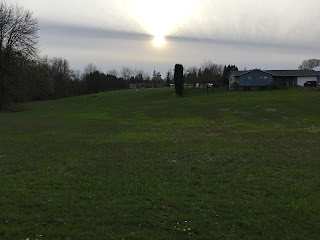The Stockman Grass Farmer has highlighted work done by a variety of researchers and researcher authors regarding the impact to our foods related to managing animals on pasture vs. what is now considered conventional methods of animal rearing. Interestingly, these "conventional" methods have only been conventional for the last 50-70 years. Before them, those methods would have been considered unconventional or fadish, or perhaps, "new-fangled," depending on with whom you spoke.
Let's consider a few representative animal products. First, let's talk about chickens. Historically, chickens were fundamental to a diversified farm. The chickens free-ranged. They ate bugs, grass, worms, weed seeds, occassional rodents or small snakes, rotten fruit, kitchen scraps, and the occassional handful of grain tossed out by the farming family. Chickens largely fed themselves. They worked on the farm by minimizing pest pressure and cleaning up things that would have otherwise gone to waste. I chuckle everytime I see a carton of eggs at the store that says, "100% Vegetarian Feed." Seriously? Anyone who has had chickens knows that chickens are not vegetarians. How in the world it could be considered a good thing to feed an omnivore a vegetarian diet is beyond me. The chickens got out, exercised, had a broadly varied and nutritional diet. What about the animal products that humans eat that resulted from that chicken diet? Eggs and meat are the primary products.
Have you ever seen a fresh, free-range chicken egg compared to a store bought egg?
Store bought on the left, free-range on the right
Eggs from chickens with access to fresh grass are dramatically different from eggs from caged layers fed a mixture of soy, corn, and a few minerals on a feed conveyor belt in a totally enclosed, climate controlled factory egg farm. A few years ago The Mother Earth News commissioned a study that compared eggs from free-range hens to conventionally raised and confined hens. Let's just say that the eggs have some stark differences, including vastly higher beta carotene, vitamin D, omega 3 fats, retinol, etc. Additionally, the taste is much richer. Baked goods baked with free-range eggs are better formed - from many bakers in the kitchen at my house.
Currently, in the U. S. the per capital consumption of chicken is about 90 pounds. That is a ratio that is unprecedented. Historically, excess roosters were eaten as "fryers" or broilers and old hens, past productive laying years, were eaten as chicken stew or chicken soup. Per capita consumption of chicken was 5-10 pounds 100 years ago. That is no longer the case. Historically, all of those good things that were in the free-range eggs were found in the meat of the free range chickens, which similarly, is a far cry from the factory raised meat chickens of today. Today's conventional meat chickens eat a diet that is largely based on corn and soybeans. But meat chickens can successfully be raised on grass and gain the same nutritional benefits of the free-range chickens of yore. These pasture raised chickens have access to grass, bugs, worms, sunlight, fresh air, etc., that help to build a more healthy nutrient profile in their meat.
What about grass-fed beef? Animals raised soley on mother's milk as young calves and grass for the remainder of life have a vastly different nutrient profile to their meat that animal raised on the range for 2/3 of their lives then corralled in a confined animal feeding operation (CAFO) for the last 1/3 and feed an unnatural diet of corn, a little hay, corn silage, more corn, bakery waste, more corn, brewer's spent grain, sodium bicarbonate (to offset the extreme acid stomach conditions caused by the corn), hormone implants, rendered fat, and a few minerals. To be clear, the diet that beef animals receive in a CAFO would be analogous to a human being fed a daily diet of four dozen doughnuts, a small ham sandwich, a serving of broccoli, and going on female hormone replacement therapy, whether male or female, intact or not. Large game animals, such as deer and elk have an omega 6/3 ration of somewhere between 1/1 and 2/1. Grass fed beef has a similar omega 6/3 ratio. CAFO fed beef has an omega 6/3 ratio of about 20/1. Is that bad? An imbalanced ratio will lead to inflammation in the human body leading to heart disease, dementia, arthritis, some cancers, diabetes, and a host of other ailments. Grass fed beef (and dairy products) also is high in conjugated linoleic acid (CLA) which prevents cancer and can stall or even reverse it in some cases. Grass-fed beef is high in beta carotene, retinol, vitamin D and other nutrients contained in low levels for conventionally raised beef.
Other pasture raised animal products that provide humans benefits are wide and varied. Omivores that pass along similar benefits as chickens include turkey, duck, guinea hen, and pigs. Ruminants benefit the most from being pasture raised. In addition to beef cattle, sheep, goats used for meat pass along the same benefits. Additionally ruminants kept for dairy products pass along the same benefits in their dairy products. Although there may have been other confounding factors in the study, Dr. Weston Price documented the clear seasonal decline in heart related deaths that corresponded to the spring time fresh supply of grass-fed butter in the U. S. back in the 1930's.
Grass-fed butter on left, conventional confinement butter on right
While books could be written on the health benefits of pasture and grass to both animals and humans consuming animal products (and they have), a clear, concise, well-written summary of benefits may be found in an article written by Jo Robinson, Health Benefits of Grass-Fed Products.
I would also say that as a side benefit, just seeing animals out on pasture provides health benefits. Pastured animals provide and idyllic scenery that causes peace and contentment.... I may only be speaking for myself. I will let you be the judge of that....















